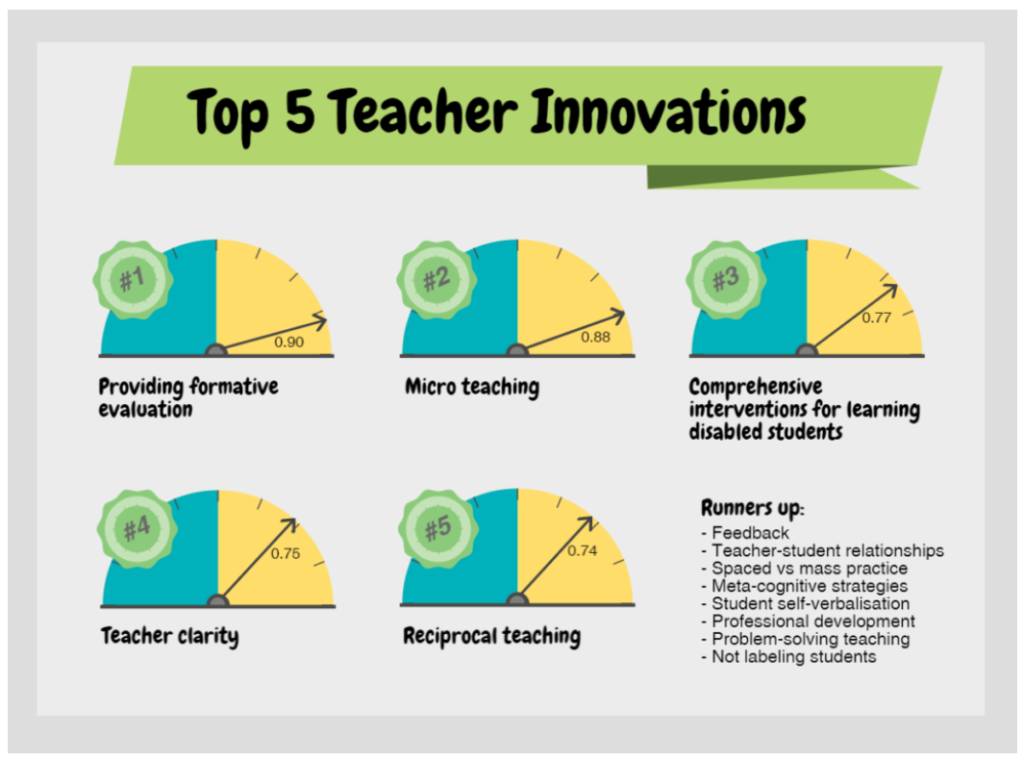Can teachers be innovators too?

Our job as teachers… is not to prepare students for something; our job is to help students prepare themselves for anything.
– A.J. Juliani (2018)
These days, being a teacher means working in a rapidly changing space where ideas about what it means to be a teacher is being challenged constantly, and the tools with which we teach are changing even faster. An ability to respond to these changes by effectively using the ever-changing technological tools within sound pedagogical practice is essential for being an innovative teacher.
Where does innovation originate?
The concept of innovation is of Greek origin (καινοτομία; kainotomia), from the 5th century BC. The word ‘innovation’ is derived from καινός (kainos; new). In the 5th century, the word had nothing to do with our current understanding of innovation. Instead it meant ‘cutting fresh into’- it was used in the context of abstract thinking as well as concrete thinking. In the hands of ancient philosophers and writers on political constitutions, innovation is ‘introducing change to the established order’.
The Greek physician Galen (129-199 AD) was one of the first examples in written history to use the word ‘innovation’ in a positive sense. And, while novelty was certainly everywhere at that time, it was only accepted as long as it did not change the divine or natural order of things. In fact, the very idea of innovation in some areas was considered positively subversive.
Fast forward several hundred years, and for any individual or organisation who wants to present themselves as modern, creating something new or using technology will almost certainly apply to the increasingly ubiquitous label of ‘innovation’.
In the business world, ‘innovation’ can mean something risky, costly and time consuming (Costello & Prohaska, 2013). Being innovative in this context means to think in problem-solving ways, to exploit new resources or use existing resources in a more efficient way (Huebner & Fitchel, 2015). According to Shapiro (2018), when done right, a culture of innovation can give you a leg up in a highly evolving marketplace.
How can we be innovative in our teaching?
In the world of education, innovation comes in many forms – there are innovations in instructional techniques and delivery systems. By their very nature, innovations are new and untested. Therefore, it is not always possible to expect innovations to be evidence-based. However, caution should be exercised to ensure that in our eagerness to be innovative we are not doing harm. Innovation can be very costly for students if we don’t get it right.
According to the US Department of Education, innovation is based on curiosity, the willingness to take risks, questioning and challenging the status quo, and experimenting to test assumptions. Hattie (2009) suggests the top five teacher innovations (see below). In this text he goes on to argue that the most influential innovations a teacher can make are to reflect on their own pedagogical practice and to make the process of learning visible to their students.
Inspired by A.J. Juliani‘s innovation strategy, this is my innovation strategy:
- Look for the gaps and do something about it
- Do some research
- Discuss my planned innovations with my colleagues
- Explain the ‘why’ to my students
- Reflect
- Collect feedback in as many forms as possible
- Share the results
- Measure the innovation
- Reflect
- Keep looking for the gaps
Does innovation only relate to technology?
No, innovation is not just about technology. However more recently, innovation does seem to have become synonymous with technology. Although not everyone is comfortable with technology in their teaching spaces, it is worth reminding ourselves that technology in our classrooms is not a new phenomenon. For example, it wasn’t that long ago that the introduction of the scientific calculator in the mid-1980’s caused great debate about the damage it would do to student learning.
Furthermore, computer processed assignments, which are the norm today, were also very contentious technology innovations. When I started university in 1994 at Wits in South Africa, I was one of the very few students in my faculty submitting assignments in Word processed format. There were departments within the Arts faculty that were very against this kind of innovation. Some of the objections I heard were that it would make students lazy, ruin their handwriting and even that it was considered, by some, as a form of cheating because of spell check and other formatting functions which we now take for granted.
Are there risks associated with being innovative?
Yes. When we do anything that is different there is risk involved, particularly if it involves people moving away from something they are comfortable with. Hattie (2009) warns that when we decide to be innovative we must consider the risks. We can borrow from Change Management theory when thinking about bringing innovation into our teaching spaces – we must ensure that we bring our students along on the journey of the ‘why’ behind our innovations. Innovation shouldn’t be done on our students, instead students should be informed partners in understanding why they should jump willingly into something different.
The example of Peer instruction pioneered by Eric Mazur at Harvard university is an excellent example of the risks that can be associated with being innovative. Mazur taught a first year Pre-Med Physics class. He noticed that his students did well on their exams, but questions that required deeper level understanding were poorly answered. He began changing how he delivered his classes and began to implement peer-learning strategies, which was very innovative at the time – no more ‘sage on the stage’. The exam results improved as students were able to answer much more difficult questions, and his overall class average went up.
However, an unexpected risk came from the students themselves – they criticised Mazur, a lot. In student surveys they gave him terrible feedback, even suggesting that he was lazy and not teaching them properly. Mazur was definitely an innovator using peer learning long before most of us had even heard of it. But, Mazur’s example demonstrates that there can be risk involved so having evidence to support your innovation and sharing any evidence with your students is essential.
Are we rewarded for being innovative teachers?
In the higher education sector, we are generally rewarded for research and not for being innovative teachers. However in recent years, there has been increasing focus on teaching practice – becoming a HEA fellow and a fellow with the HERDSA fellowship program are two ways teachers are being recognised for excellence.
Could we be doing more to reward teaching innovation? Yes of course. But a first step towards knowing you are innovative in your teaching is to share your practice and get feedback from your peers and students.
To watch the ‘Can teachers be innovators too?’ webinar, click here. To continue the conversation, contact Gemma Clarke, or share your thoughts and ideas via Yammer, Twitter or LinkedIn.
References
- Banks, S. (2011). A historical analysis of attitudes toward the use of calculators in junior high and high school math classrooms in the United States since 1975(Thesis). Retrieved from http://digitalcommons.cedarville.edu/education_theses/31
- Costello, T. & Prohaska, B. (2013). Innovation. IT professional, 15(3), 62-64.
- Godin, B. (2012). “Innovation Studies”: The invention of a specialty. Minerva, 50 (4), 397-421.
- Godin, B. & Lucier, P. (2012). Innovation and conceptual innovation in Ancient Greece (Project on the Intellectual History of Innovation Working Paper No. 12).Montréal, Quebec: INRS.
- Hattie, J. (2009). Visible Learning: A synthesis of 800+ meta-analyses on achievement. Oxford: Routledge.
- Huebner, F. & Fichtel. (2015). Innovation and behavioural flexibility in wild red fronted lemurs. Animal Cognition, 18(3), 777-787.
- Lowe, G. (2016). Dazzling Data: 5 teacher innovations to enhance student success. Retrieved from https://learningandteaching-navitas.com/dazzling-data-the-top-5-teacher-innovations-that-enhance-student-success/
- Shapiro, S. (2018). How to create a culture of innovation. Retrieved from: http://stephenshapiro.com/how-to-create-a-culture-of-innovation/

